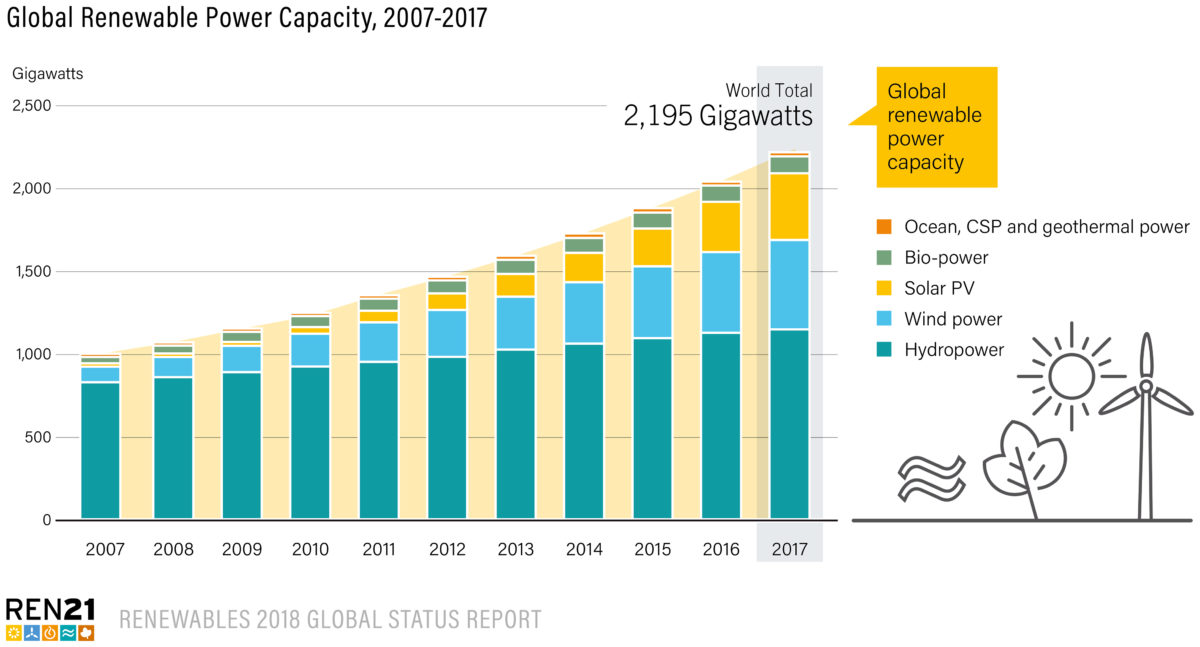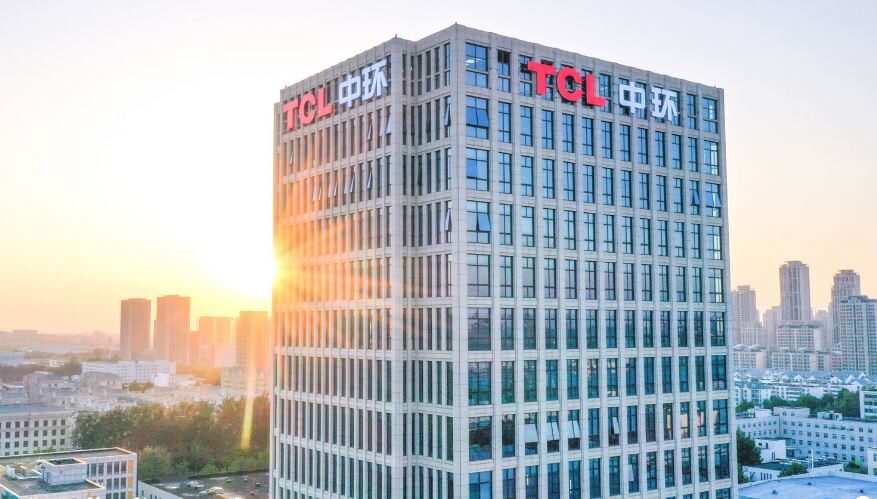REN21’s Renewables 2018 Global Status Report highlights record installations of solar PV while noting renewables are losing share in the global energy mix as booming economies and rising populations drive a soaring demand for power.
Energy demand (up 2.1%) and energy-related carbon dioxide emissions (1.4%) both rose substantially for the first time in four years in 2017. Renewable energy uptake is not keeping pace amid continuing investment in fossil fuel and nuclear capacity.
Record installations still not reducing global carbon output
Last year saw renewable power generating capacity rise almost 9% compared to 2016 – its largest annual increase – to hit 178 GW installed globally. PV installations accounted for 55% not only making the technology leader among newly-installed renewables, but also outpacing net additions of fossil fuel-fired and nuclear power combined. With an installed capacity of 98 GW by the end of 2017, solar PV additions went up a record 29% year-on-year.
Renewable energy accounted for an estimated 70% of net additions to global power capacity last year, up from 63% in 2016 and by December, global renewable power capacity totalled around 2,195 GW – enough to supply an estimated 26.5% of global electricity.
However, REN21 Chairman Arthouros Zervos warned: “To make the energy transition happen there needs to be political leadership by governments, for example by ending subsidies for fossil fuels and nuclear, investing in the necessary infrastructure and establishing hard targets and policy for heating, cooling and transport. Without this leadership, it will be difficult for the world to meet climate or sustainable development commitments.”
More for less – cost reductions increase installation despite reduced investments
Falling system costs and more attractive financing models have caused the absolute level of investment in PV and other renewable technologies to decline while net additions increased. Emerging economies account for a large share – 63% – of overall investment into the market, with China alone making up 45%.
Global investment in renewable power and fuels in 2017 totalled $279.8 billion (excluding hydropower plants larger than 50 MW) – up 2% from 2016 but 13% below the all-time high seen in 2015. Most of that sum was invested in PV (57%) and wind power (38%). Investment in 2017 held steady or trended upwards in Latin America and the United States, but fell 30% in Europe, where it has been in decline for more than seven years.
The improved cost-competitiveness of renewable energy generation has accelerated the decline in the average global levelized cost of energy (LCOE), especially for solar PV, making the technology an increasingly mature response to soaring energy demand. The global weighted average LCOE of utility-scale solar PV fell 73% between 2010 and 2017 and renewable energy tenders in 2017 saw record low bid prices for PV and wind in several countries, as low as $30/MWh for onshore wind and for PV.
Corporate investments gravitate towards solar
Private sector investments into the sector, an increasing demand for self-consumption and an expansion of corporate power purchase agreements (PPAs) have resulted in a solid 26% increase in renewable energy installations, accounting for 5.4 GW globally.
Additionally, large oil corporations more than doubled their number of acquisitions, project investments and venture capital stakes in renewable energy in 2016 relative to 2015, and 49% of all deals over the past 15 years have involved renewable energy, the majority of it PV.
Transport and heating potential
“Equating ‘electricity’ with ‘energy’ is leading to complacency,” said Rana Adib, Executive Secretary of REN21. “We may be racing down the pathway towards a 100% renewable electricity future, but when it comes to heating, cooling and transport, we are coasting along as if we had all the time in the world. Sadly, we don’t.”
Sector coupling – the interconnection of the power, heating, cooling and transport sectors to integrate a higher share of renewable energy – gained attention last year. The electrification of heating and transport – although currently negligible, particularly in transport – is seen as a potential pathway to the expansion of renewable energy, and an accompanying reduction in carbon emissions, and specifically as a means to integrate large shares of variable renewable energy.
As of 2015, heating and cooling accounted for 48% of the world's total final energy consumption (TFEC), followed by transport (32%) and electricity consumption (20%). As the integration of variable, renewable energy (VRE) technologies becomes an increasingly central issue for many energy markets, such technologies could provide a remedy to the relatively small share renewables occupy in transport and heating. To reduce curtailment of wind and solar PV, for example, Chinais putting in place programs to electrify residential heating, manufacturing and transport in regions with high renewable energy generation.
In other markets – notwithstanding reductions in FITs – electricity from PV for residential heat generation is becoming an increasingly important topic, as array owners seek options to increase self-consumption.
Oil-based fuels are still the biggest provider of energy – with a 92% share – in the transport sector. Biofuels (2.8%) and electricity (1.3%) make up only a tiny proportion of the energy mix for the sector. The lack of progress demonstrates the market opportunity open to PV and other renewables. With electric vehicles slowly gaining momentum – at least in markets like China and Norway – the demand for renewable energy is likely to increase.
Curtailment of solar PV has decreased year-on-year from 2016 to 2017 – from 10-11% to 6-7% in China, for example. Globally, markets and policy makers have reacted to increasing VRE installations by introducing mechanisms for the increased flexibility of grids, with promising results.
Renewable energy take-up is growing, but too slowly to meet climate change goals. After good advancements in the electricity sector, the conclusion of the report is that transport and heat must follow the lead of electricity generation. That offers great potential for PV and is pivotal for meeting the COP 21 climate change ambition.
This content is protected by copyright and may not be reused. If you want to cooperate with us and would like to reuse some of our content, please contact: editors@pv-magazine.com.




This article provides a great reality check in that only 20% of emissions come from electricity-production related sources. While many innovations are on the horizon for the way business is done in the electricity sector around the world, a huge field of opportunity exists in the transportation and heating/cooling sectors. The time to get busy is now if we want to have any realistic chance of keeping the average temperature rise below 1.5degC. Sobering.